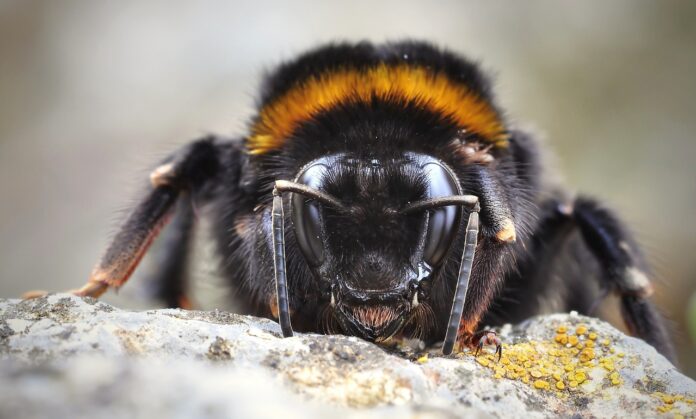Bumblebees are one of nature’s most remarkable and hardworking insects. These fuzzy, vibrant pollinators play a crucial role in maintaining the health of ecosystems and supporting agriculture. Despite their small size, bumblebees are powerful pollinators with a unique set of characteristics and behaviors.
The Origins and Biology of Bumblebees
Bumblebees belong to the genus Bombus and are part of the family Apidae, which also includes honeybees, carpenter bees, and stingless bees. There are over 250 species of bumblebees found around the world, primarily in temperate climates. These bees are known for their distinctive black and yellow striped bodies, although some species may have orange, red, or even white markings.
One of the most interesting aspects of bumblebees is their size and structure. They are generally larger and hairier than honeybees, which helps them stay warm in colder climates. Bumblebees have a robust body and strong wings, enabling them to carry large amounts of pollen and nectar back to their colonies. Unlike honeybees, bumblebees can sting multiple times without dying, although they are generally non-aggressive and sting only when threatened.
Bumblebees Are Vital Pollinators
Bumblebees are among the most efficient pollinators in the insect world. Their large, hairy bodies allow them to collect and transfer more pollen as they move from flower to flower. This makes them particularly valuable for pollinating crops such as tomatoes, peppers, and berries, which rely heavily on bumblebee pollination for high yields.
Bumblebee Social Structure and Behavior
Bumblebees live in small colonies, usually consisting of a queen, female worker bees, and male drones. Unlike honeybees, whose colonies can number in the tens of thousands, bumblebee colonies are much smaller, typically housing between 50 and 400 individuals. The queen is responsible for laying eggs, while the workers gather food, care for the young, and maintain the nest.
Bumblebee nests are often found in the ground, such as in abandoned rodent burrows, or in grassy areas. They may also nest in compost heaps, under garden sheds, or in wall cavities. A bumblebee colony is seasonal, with the queen emerging in the spring to establish a new colony and laying eggs throughout the summer. By late autumn, the colony naturally dies off, leaving only newly mated queens to hibernate and start new colonies the following year.
The Story of the Bumblebee Conservation Project
In recent years, bumblebee populations have been declining due to habitat loss, pesticide use, and climate change. To combat this trend, several conservation projects have been launched worldwide. One of the most notable is the Bumblebee Conservation Trust in the United Kingdom, which works to protect and restore bumblebee habitats.
The Trust’s efforts include creating wildflower meadows, promoting bee-friendly farming practices, and conducting research on bumblebee ecology. Their work has led to the stabilization of some bumblebee species that were once in decline, showcasing the importance of conservation efforts in preserving these essential pollinators.
The “Impossible” Flight of the Bumblebee
For many years, scientists believed that bumblebees should not be able to fly based on the laws of aerodynamics. Their large bodies and small wings seemed to defy the principles of flight. This led to the popular myth that bumblebee flight was a mystery beyond scientific explanation.
However, modern studies have shown that bumblebees achieve flight through a combination of rapid wing beats, creating lift in a manner similar to how helicopters fly, and their ability to control the angle and rotation of their wings. This discovery not only solved the mystery of bumblebee flight but also inspired advancements in aerodynamics and micro-aircraft design.
The Accidental Bumblebee Invasion
In 2006, the UK experienced an unexpected influx of an unusual species of bumblebee, the Tree Bumblebee (Bombus hypnorum). Originally from mainland Europe, this species quickly established itself across the country, thriving in urban environments and adapting well to garden settings. The Tree Bumblebee’s spread has been one of the fastest insect invasions recorded, and it continues to expand its range.
While the arrival of the Tree Bumblebee has not negatively impacted native species, it has sparked interest among entomologists and conservationists who are monitoring its integration into local ecosystems. The adaptability and rapid spread of this species highlight the resilience and versatility of bumblebees in changing environments.
The Role of Bumblebees in Space Research
Bumblebees have even made their way into space research. In 1984, NASA conducted an experiment to observe the behavior of bees in microgravity aboard the Space Shuttle Challenger. The experiment, known as the “Bee Enclosure,” aimed to study how bees, including bumblebees, would adapt to weightlessness.
The results were fascinating: initially, the bees struggled to fly and orient themselves in the zero-gravity environment. However, within a few days, they adapted, learning to navigate and perform their tasks in the absence of gravity. This experiment provided valuable insights into how insects—and possibly other living organisms—might function in space, with implications for long-term space travel and colonization.
